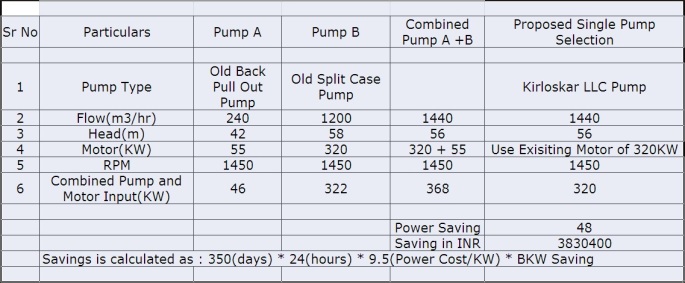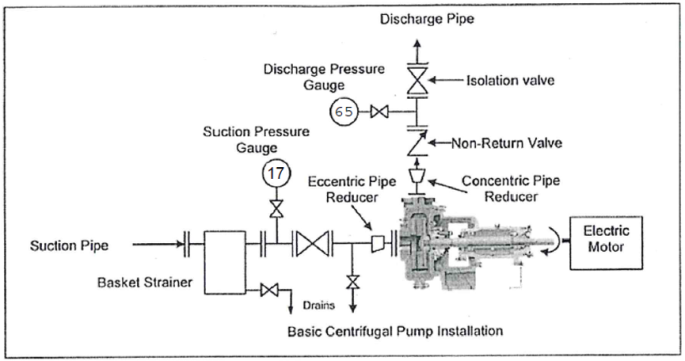Hi Friends!!!
Energy Saving/Power Saving in today’s world has become a very big concern. With depleting resources one of the major focus of companies today is to save energy and inturn reduce their power consumption.
We did a similar project at one our esteemed customer M/s BPCL Ltd Mumbai.
The project was initiated jointly by our team and executives of M/s BPCL and below were the steps taken.
- Identifying Old pumps in the plants , preferably the pumps older than 15 years.
We started collecting pump population of the plant and started to shortlist the pumps which were above 15 years old.
Generally as per HIS standard the efficiency of the pump deteriorates by 1-1.5% per year hence we chose the pumps which were older than 15 years old as candidate for Power saving.
2) Conducting Energy Audit of these pumps.
Once we selected the candidate pumps we did energy Audit of these pumps.
Generally over the years , the operation parameters of the pump changes , this happens due to change in duty point parameters , upgradation of plant , change of application requirement and many other factors.
Hence the duty point generally changes on the curve and does not operate at the parameters at which it was procured years ago.
If these changed parameters fit in the range of the exisiting pump then the pump operates and gives desired results however silently it takes more power since the efficiency of the pump reduces with the change in parameters.
Also the pump being old , there are lots of wear and tear , frictional losses etc.
Hence doing energy Audit of the pump is very important as it shows the current statistics of the pump ie The flow , Head , BKW , RPM and hence the efficiency of the pump.
On conducting this energy audit at BPCL we found out that few pumps were operating at a very low efficiency , thus taking high power.
3) Selecting New pump with current site Flow , Head and other parameters.
Once we got the energy audit results , we selected the best efficient pump with highest efficiency , suitable for the current conditions , but having provision of the original procured parameters.
The Details of the old pump , Audit Report and proposed New pump is shown in below snapshot just for reference.

4) Lowest Life Cycle Cost Pump.
We proposed M/s BPCL to replace the pump with KBL’s LLC Pump.
M/s Kirloskar Brothers Ltd has launched a pump called Lowest Life Cycle Cost pump ( LLC Pump)
It is designed in such a way that the efficiency deterioration doesnt happen. Generally as per HIS the efficiency of the pump deteriorates by 1-1.5% , however in LLC pump the efficiency drop is hardly 0.2% per year.
Below are the features of the LLC pump which sustains efficiency and thus contributes largely towards Energy Saving
a) Efficiency Enhancing coating from Kirloskar Corrocoat which increases efficiency by 2% and also does cause frictional losses.
b) Hard Mettalic Serated Wearing Rings.
c) Radial load balanced double volute casing design.
d) Cartridge type mechanical seal by default.
e) Specialized Throttle bush design which reduces energy consumption.
f) L10 Bearing Life with excess of 50000 hours life and API Type double row thrust bearing assembly.
g) Reduced shaft length with SS-431 Material as standard. This ensures low Low L3/D4 ratio resulting into minimum deflection and optimum efficiency.
All other features are mentioned in the enclosed Leaflet in details.
 Link to the Leaflet of Kirloskar Make LLC Pump is as below
Link to the Leaflet of Kirloskar Make LLC Pump is as below
5) New Pump replacement Audit and The conclusion.
Based on our recommendation M/s BPCL replaced the pump , after all the commissioning activities we started the pump and put it in operation.
To prove the claimed power saving , we once again did the Post Energy Audit and we are very happy to inform that the new pump is running with enhanced efficiency.
M/s BPCL has got the Payback of their investment in just 4.5Months.
This blog post is just for reference purpose and hence we have not mentioned pump model , commercial prices or any other specific data. That needs to be done by the customer individually as per their organisation standards and site conditions.
We hope the readers also take up such kind of projects and save energy / save power through proper pumping.
Incase any support required then you can contact us.
Thanks and Regards
Siddharth D Bhimani
Email : savenergy@sialkbl.com





